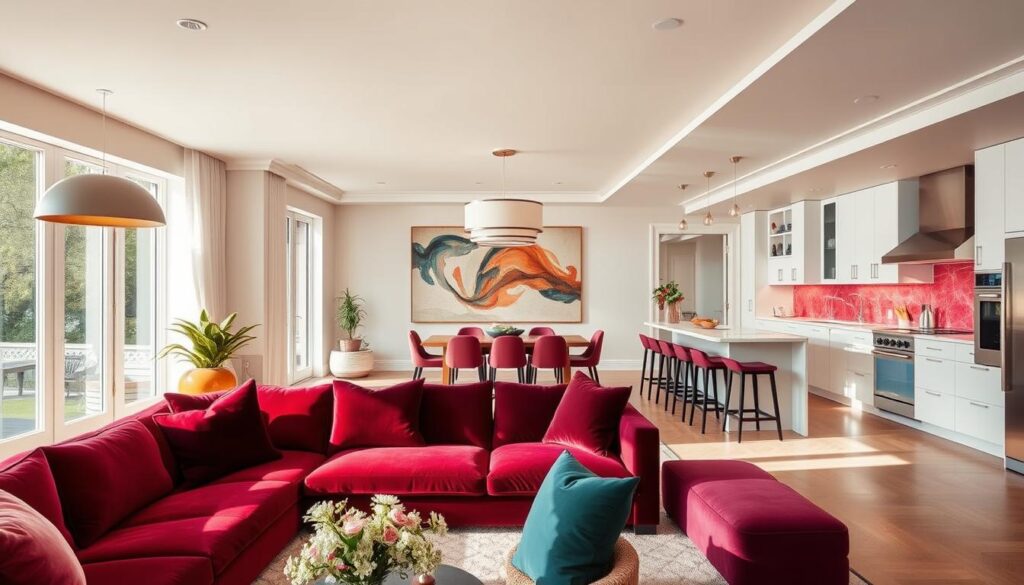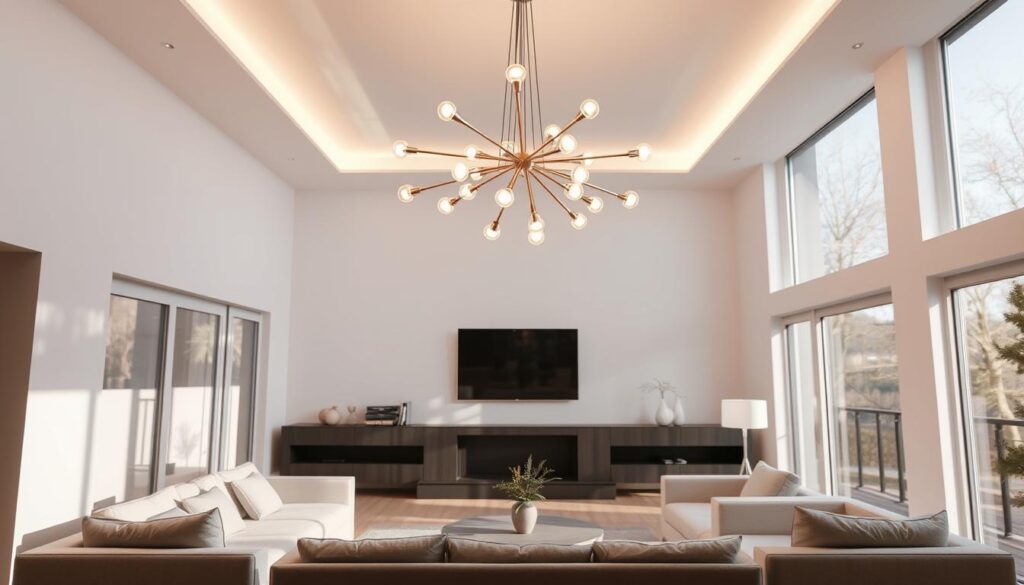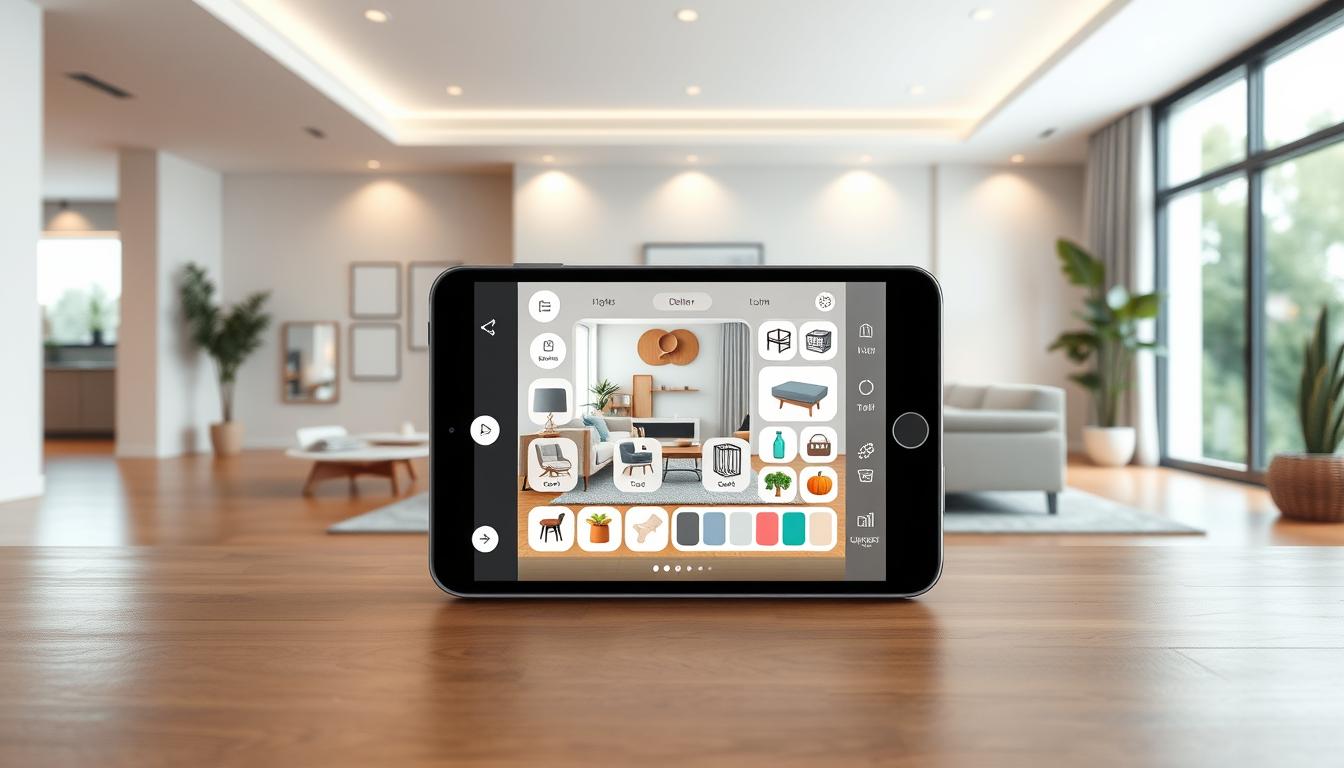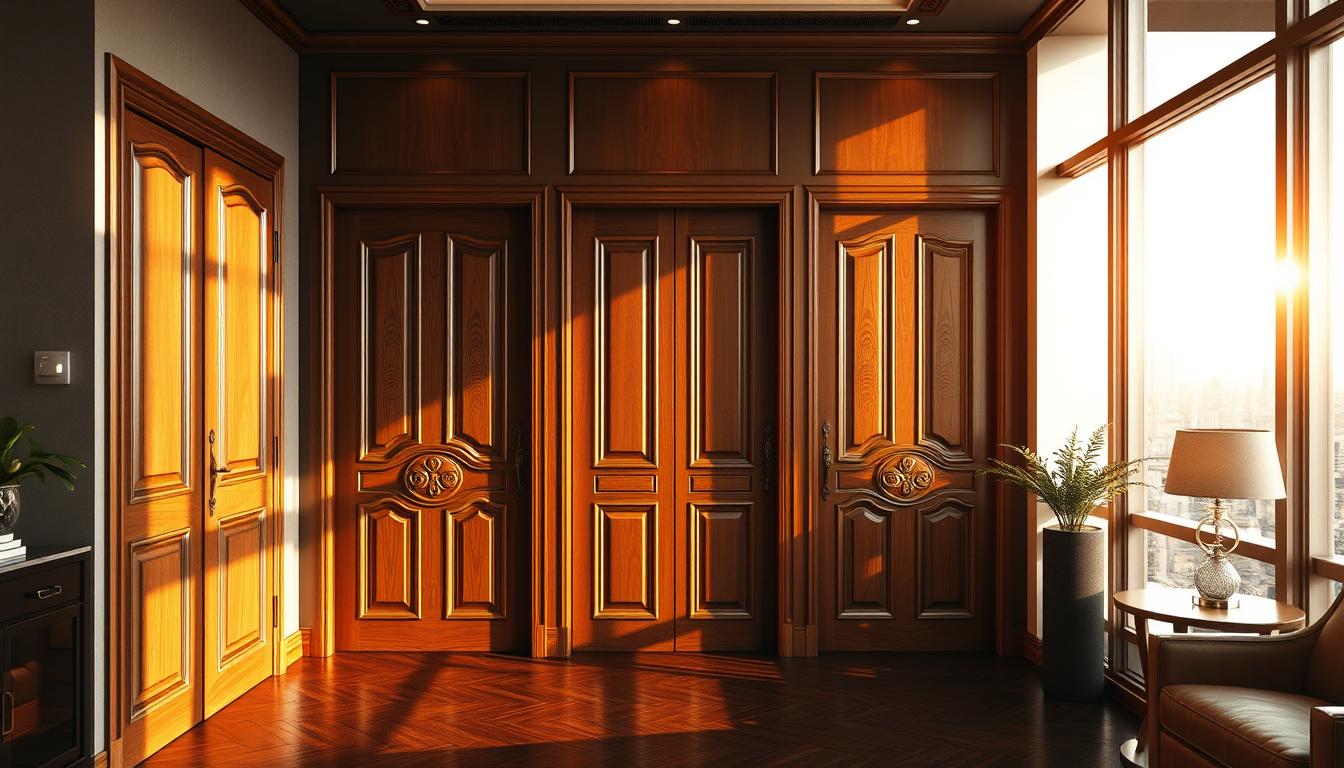Did you know the interior design industry is growing by 5% every year? This growth is because people want unique and personalized homes. As we look ahead to 2025, modern home styles are getting bolder, greener, and more practical.
We’ll check out the newest interior design styles and trends that are changing what we think of as luxury and comfort. From looking at different interior design styles to adding the latest trends to your decor, we’ll share top tips. These tips will help you make your home look amazing.
Key Takeaways
- Discover the top interior design trends of 2025
- Learn how to incorporate bold colors and sustainable materials into your decor
- Explore the latest modern home styles and interior design styles
- Get expert tips on multifunctional furniture and decor
- Understand how to elevate your living space with the latest trends
What Are Popular Home Styles?
Exploring home decor means understanding different styles. These styles change how we live and what we like. We’ll look at popular styles like modern, traditional, contemporary, industrial, and rustic.
Defining Modern, Traditional, and Contemporary
Modern decor is all about simplicity and function. It uses neutral colors and materials like glass and steel. Traditional home decor, in contrast, loves classic looks with rich colors and detailed patterns.
Contemporary interiors blend current trends with various styles. It’s about making a space that feels new and exciting.
| Style | Characteristics | Key Elements |
|---|---|---|
| Modern | Clean lines, minimal ornamentation | Glass, steel, concrete |
| Traditional | Classic, timeless appeal | Rich colors, intricate patterns, ornate furnishings |
| Contemporary | Fluid, reflects current trends | Varied styles and elements |
Exploring Industrial and Rustic Styles
Rustic home interiors love natural materials like wood and stone. They make spaces feel cozy and welcoming. Industrial style, inspired by old factories, uses exposed brick and metal beams.
For more style ideas, check out House Beautiful. They cover styles like Japandi and Alpine Chic. Japandi mixes Scandinavian and Japanese styles, while Alpine Chic is inspired by Swiss chalets.
Key Elements of Interior Design
Interior design is about finding the right mix of elements for a space that looks good and works well. We’ll look at how color and furniture choices can make your home stand out.
Color Palettes: Making Your Space Shine
Picking the right colors is key in interior design. It sets the mood of your space and affects how it feels. For 2025, expect to see bold, rich colors and earthy neutrals. These options fit many interior design styles.
Think about the light, furniture, and look you want when choosing colors. Bold colors bring energy, while neutrals offer a classic feel. For example, mixing deep blues with warm neutrals can make a space feel both sophisticated and welcoming.
“Color is a power which directly influences the soul.” – Wassily Kandinsky
To get a balanced look, use the 60-30-10 rule. This means 60% of a main color, 30% of a secondary color, and 10% of an accent color. This rule helps create a space that looks good.
| Color Scheme | Description | Best for |
|---|---|---|
| Monochromatic | Using different shades of the same color | Modern home styles |
| Complementary | Pairing colors opposite each other on the color wheel | Eclectic design |
| Analogous | Using colors next to each other on the color wheel | Traditional interiors |
Furniture: Choosing Functional Pieces
Furniture is more than just looks; it must also be useful. In today’s homes, pieces that do more than one thing are popular. They help keep spaces tidy and organized.
Think about what each piece of furniture does and how it fits into the room. For example, a storage ottoman can be a seat and a place to store things, making a room more functional.
To get a balanced look, mix different styles and textures. For example, combining a modern sofa with a vintage armchair can add personality to a room.
- Make sure furniture fits the room’s size.
- Choose materials and textures that match your color scheme.
- Buy furniture that’s both stylish and practical.
By picking the right colors and furniture, you can make a home that’s both beautiful and welcoming. It will show off your personal style.
The Rise of Sustainable Design
Concern for the environment is growing, making sustainable design key in modern decorating. We want homes that are beautiful and good for the planet. This change helps us reduce our environmental impact.
Eco-Friendly Materials for Your Home
Using eco-friendly materials is a big part of sustainable design. These materials are made and sourced in ways that are kind to the earth. Examples include reclaimed wood, bamboo flooring, and low-VOC paints.
Adding these to your home can make it more eco-friendly. This helps reduce harm to our planet.
Tips for a Green Interior Design
Green interior design is more than just choosing the right materials. It’s about thinking about the whole environmental effect of your choices. Here are some tips to help:
- Choose energy-saving appliances and lights to cut down on energy use.
- Go for natural textiles and materials that are good for the planet.
- Think about giving old furniture a new life to avoid waste.
- Add plants to your space; they clean the air and make it look natural.
By following sustainable design, we can make homes that look great and are good for the earth. Sustainable design is not just a trend. It’s a crucial step towards a greener future.
Color Trends Transforming Interiors
Color trends are changing how we decorate in 2025. We’re seeing bold accent walls and soothing neutrals. The right colors can totally change a room’s feel.

Bold Accent Walls to Consider
Bold accent walls are back in 2025. They add depth and character to any room. Think about the room’s purpose and the mood you want to create.
For example, a deep blue can make a bedroom calm. A vibrant red can energize a living room. Choose a bold color wisely.
To use bold accent walls well, pick a wall that stands out, like behind a fireplace or a bed. Balance the bold color with neutral tones on other walls and furniture. This prevents the space from feeling too much.
Neutrals: Timeless Choices for Any Room
Neutral colors are still a classic choice for interior design. Beige, cream, and soft gray are versatile and calm. They work well with any style or decor.
Neutrals can be made interesting with furniture and decor. For example, add patterned rugs, throw pillows, and unique lighting. This way, we can keep the room simple yet add our own touch.
By mixing bold accent walls with neutral colors, we can make interiors that are stylish and personal. Whether you like bold statements or subtle touches, the key is to have fun and try different colors and combinations.
Creating Open vs. Cozy Spaces
Choosing between open-concept living and cozy spaces is a big decision in home design. It depends on our lifestyle, what we like, and our home’s layout.
Open-concept living is popular for making spaces feel bigger and easier to move around. It removes walls, allowing for more interaction and activities at once.
Benefits of Open-Concept Living
Open-concept living makes spaces feel larger, which is great for small homes. It also lets in more natural light, making rooms brighter.
- Enhanced sense of spaciousness
- Improved natural lighting
- Easier social interaction
But, open-concept living has downsides. It can be hard to find quiet spots, and it might feel chaotic with many people.
Achieving Warmth in Smaller Areas
Cozy spaces are perfect for relaxing and feeling close. Use rich textures, warm lights, and comfy furniture to make small areas feel snug.
Tips for Cozy Spaces:
- Use warm, earthy tones for walls and furniture
- Incorporate plush textiles like throw blankets and pillows
- Employ soft lighting to create a warm ambiance
In small areas, finding the right balance is key. Choose furniture that does more than one thing and plan your layout well. This way, you get a cozy space that’s also practical.
In conclusion, whether to choose open-concept living or cozy spaces depends on what we need and like. Understanding both options helps us design homes that fit our lifestyles.
The Importance of Lighting in Design
In interior design, lighting is key to setting the mood of a space. It lights up the area and shows off the design, making it feel cozy and inviting.
Lighting falls into two main categories: natural and artificial. Natural light is vital for making a space feel bigger and more welcoming.
Natural Light: Enhancing Your Space
Natural light greatly affects our mood and health. It can make us feel happier, less stressed, and sleep better. To get the most natural light, use sheer curtains or blinds. They let sunlight in while keeping things private.

Choosing the Right Fixtures for Ambiance
Artificial lighting, like lamps and ceiling lights, also shapes a room’s feel. The right fixtures can make a space feel warm and cozy or bright and lively.
Think about the room’s purpose and the mood you want. For example, a living room might need soft, warm lighting. A kitchen might do better with bright, focused lighting.
| Room Type | Recommended Lighting | Effect |
|---|---|---|
| Living Room | Warm, Soft Lighting | Cozy, Inviting |
| Kitchen | Bright, Task-Oriented Lighting | Energizing, Functional |
| Bedroom | Dimmable, Ambient Lighting | Relaxing, Calming |
Understanding lighting’s role and picking the right fixtures helps us create spaces that are both beautiful and practical. They become places where we feel comfortable and at ease.
Incorporating Technology in Home Design
Technology is changing how we live in our homes. Our homes are getting smarter, more efficient, and comfy. It’s not just about adding gadgets; it’s about making our homes fit our needs and improve our lives.
Smart home systems are a big step forward. They let us control things like lights, temperature, security, and entertainment with our phones or voice commands.
Smart Homes: The Future of Living
Smart homes have devices we can control from anywhere. For example, smart thermostats learn our habits to save energy and cut down on bills.
“The future of home design is not just about aesthetics; it’s about integrating technology to create a more sustainable, efficient, and comfortable living environment.”
Smart homes offer many benefits:
- They use less energy
- They’re more secure
- They’re more convenient
- They offer personalized experiences
Innovative Gadgets for Modern Design
There are many cool gadgets for modern homes. These include voice-controlled lights, automated blinds, and top-notch security systems.
| Gadget | Function | Benefit |
|---|---|---|
| Voice-Controlled Lighting | Adjusts lighting levels and color | Enhances ambiance and convenience |
| Automated Window Treatments | Controls light entry and privacy | Improves energy efficiency and comfort |
| Advanced Home Security Systems | Monitors and secures the home | Provides peace of mind and enhanced security |
As we add more tech to our homes, we need to make sure it fits well. This way, we can have homes that are not just pretty but also smart and responsive to us.
DIY vs. Professional Design
DIY projects can be tempting, but knowing when to call in a professional interior designer is key. The choice between DIY and hiring a pro depends on several factors. These include the project’s complexity, your budget, and your design preferences.
When to Take on a DIY Project
DIY projects can be cost-effective for simple tasks like painting or rearranging furniture. But for complex projects, you might need a pro. They have the knowledge of design, materials, and space planning.
Finding the Right Designer for You
When you decide to hire a pro, find one who gets your vision. Look at their portfolio to see if it matches your style. Ask for references too. A good designer will make your space look great and work well for you.
| Aspect | DIY Design | Professional Design |
|---|---|---|
| Cost | Generally lower | Can be higher due to professional fees |
| Expertise | Limited to personal knowledge | High level of design expertise |
| Time Commitment | Significant personal time required | Less personal time required |
Upcoming Trends to Watch in Interior Design
Interior design is always changing, and some trends are really taking off. Biophilic design and vintage interior design are two big ones to watch.
Nature-Inspired Spaces
Biophilic design brings nature into our homes. It’s all about feeling connected to the outdoors. By adding plants, natural textures, and lots of light, we make our spaces feel alive.
A Touch of the Past
Vintage interior design is also on the rise. People want to add unique touches to their homes. Using old furniture and decorations gives rooms character and personality.
By embracing these trends, we can make homes that are beautiful, sustainable, and full of meaning.



